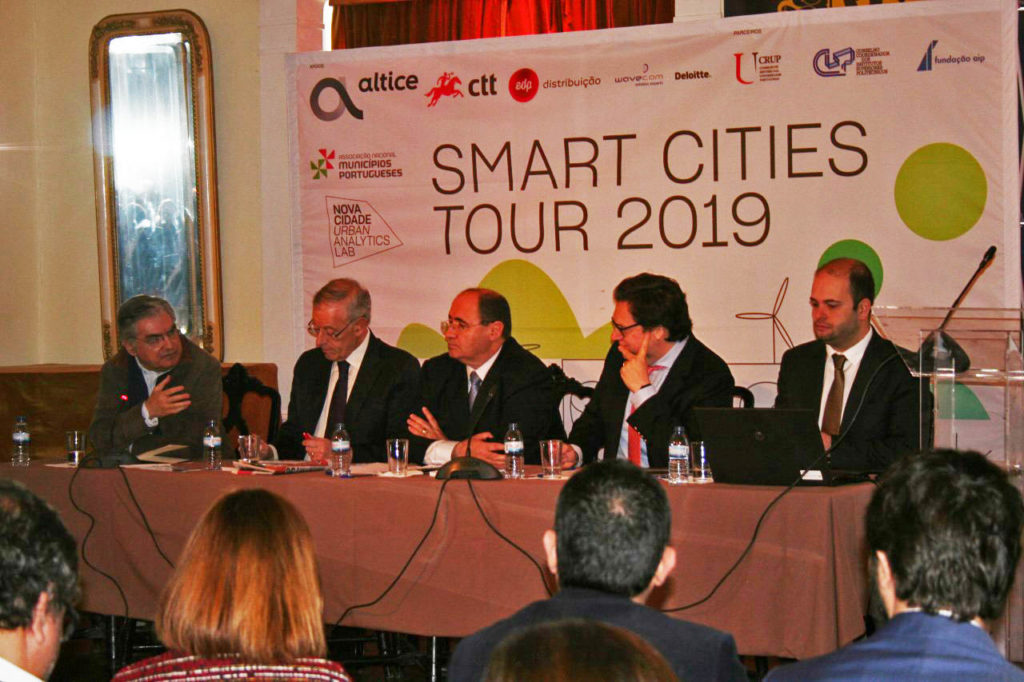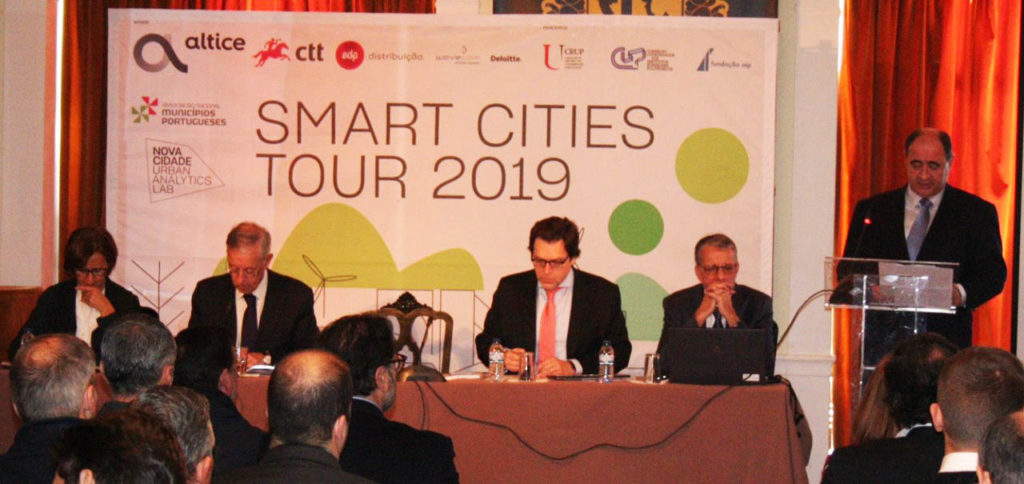On Wednesday, January 16, it took place at Clube Farense, in Faro, the first session of the Smart Cities Tour, an initiative, sponsored by the National Association of Municipalities, which travels through several cities in the country to promote digital territories and smart and creative municipalities. I was invited to make an intervention by the way and it is from that intervention that I leave this small record here.
Digital territories are a kind of new emblem of territory policies. Therefore, it is worth making an analytical effort to better understand what it consists of and what is at stake when it comes to digital territories and territorial digitization.
In contrast to the digital business, which will flood Portuguese society in all its areas of activity, the digitization of a territory needs a center endowed with a minimum of global rationality that avoids cacophony and background noise.
That is, we need a self-government structure endowed with a minimum of population, attributions, competences and means, capable of articulating sectoral and inter-municipal powers with the expectations of populations expressed through digital resources and triggering the effects of agglomeration and scale what the territory needs most.
The concept of “smart district city” that I bring here as an illustration seeks to respond to this analytical effort that includes, on the one hand, the definition of a “government of the commons” and, on the other, the design and construction of a “shared center of digital resources”.
Indeed, I do not foresee the creation of intelligent digital territories without a step forward from the municipalities towards autarchic federalism. In this sense, the “smart district city” would be the actor-network that, to this end, would create a kind of “local order” very useful to a self-governing community.
After a brief tour of the city district and the ride of this government of commons/shared center for digital resources, I will take a first look at what could be designated as a digital agenda for smart and creative municipalities.
I. Territorial intelligence: the example of "smart district cities"
Imagine, for example, the immense district of Beja, with 14 municipalities and 153 inhabitants, according to the 2011 census.
According to the concept of "smart district city", an "interactive citizenship platform" would be created with the purpose of selecting the "district common goods", multipurpose, multifunctional and itinerant, which should be placed at the service of the entire population of the district, a dispersed and diffuse network city with 153 inhabitants.
According to this new list of priorities, this actor-network or "district self-government community" would debate the nature, contents and limits of the "shared digital resource center", with a view to equipping the district with "connection infrastructures ” that enable the new digital services, as well as the operational and logistical model that would put the common goods at the service of the population of the district.
In addition, I also believe that this center of territorial rationality that I designate here as "smart district city" should precede the wave of digital business, for the simple reason that this precedence would give another consistency to the numerous technological and digital applications that will flood the market and the territories.
Well, it is certain and certain that the transformation of territories is not compatible with the speed of the digital business and within a short time we would all be lamenting the lightness and lightness of the purpose.
The “smart district cities” in the interior of Portugal would have a higher average size, they would recreate their areas of influence and this circumstance would be a unique opportunity to make common services available to them with much greater effectiveness and efficiency.
But this purpose, expressed in this simple way, is an authentic revolution in a sub-region practically extinct and now, for the most part, converted into inter-municipal communities. For several reasons.
First, it would be a revolution in municipal and inter-municipal management towards 2nd degree autarchic federalism, which would imply, from the outset, a substantial change in the internal organic of municipalities with regard to the relationship back office versus front office and the qualification structure of the technical staff of the municipalities.
Secondly, it would be necessary to fight digital illiteracy across the board in all age groups, which would also imply a profound reform in school programs and in the organization of the inter-municipal school building in its entirety.
Thirdly, the digitization of the “smart district city” would require a much more substantial policy of political-administrative decentralization, as conditions would be created for a more efficient management of scarce resources at the district level.
Fourthly, the district, in this digital sense, would have to return to being a “desired territory”, a network city for the XNUMXst century, very close to the populations and offering them a series of common, fixed goods and services. and outpatient clinics, which otherwise would not be possible.
Fifthly, to be more than a simple “smart territory” it would need new spaces of freedom in which to exercise intelligence, imagination and knowledge sharing; for example, collaborative coworking spaces have very variable structures, allow the first steps for future entrepreneurs and are also an experimental laboratory where new formats of territorial collective intelligence begin to take shape.
Sixthly, the “smart district city” (the 14 municipalities of the Beja district), in addition to the new “district utilities” would be obliged to create a “new industrial school” for the XNUMXst century, a “digital business school” in close collaboration with the business associations and other schools in the district.
Seventh, and because there are no district boundaries, the “smart district city” would have to create its “distinctive territorial signs”, an iconography appropriate to its new image and condition, that is, it would have to be a city not only smart, but, above all, intelligent and creative.
Eighth, and in a very prominent position, the “smart district city” would have to take care of its social responsibility, as the risk of digital exclusion is very high in a more or less long phase of transition; however, this is a field where the “welfare system” of the smart city could be extraordinarily innovative, with solutions that are very close to users of the various social security subsystems.
Ninth, and also in a prominent position, the “smart district city” could be very innovative with regard to labor relations with the adoption of various modalities of “economy and collaborative peer relations”; in other words, in possession of a database on labor relations, the smart city could present very creative and interesting geographical and professional mobility solutions to be applied within the district and in neighboring districts.
Finally, and despite its long-announced political-administrative demise, the district would have a second opportunity here, this time in the innovative form of an intelligent and proximity network city.
II. The Digital Agenda of Smart and Creative Municipalities
Having made this incursion into an imaginary smart territory, it is now time to outline what could be a Digital Agenda for smart and creative municipalities in the horizon of the next decade.
1. Digital strategy, what type and level of territorial intelligence do we aspire to?
2. The digital fracture, what infrastructure of the territory do we want?
3. Digital access, what collection, processing and production of relevant data?
4. Digital mobility, which residential, professional and recreational geography?
5. Digital polarization, how to prevent the dualization of the labor market?
6. Digital platforms, what business model and institutional rearrangement?
7. Culture and digital literacy, what new education and training strategy?
8. Digital cooperativism, common goods and co-production of services?
9. Digital entrepreneurship and financial engineering of local projects?
10. Digital regulation, the digital footprint and liability litigation?
Final Notes
In fact, it is proved to the evidence that a territory cannot be limited to surviving as a mere statistical-administrative unit, of the NUTS II or NUTS III type, or even CIM.
It will never truly be an intelligent and creative territory, as it will always have a low network intensity and poor sociability. On the other hand, despite their announced death, the districts still reside in our collective subconscious.
The digital revolution underway could be the rebirth of these territories, this time in the form of “smart host ecosystems”, our smart and creative XNUMXst century network cities.
In addition, it is good not to forget, districts are electoral districts, it is there that we elect our deputies and that, in this condition, they are “obliged” to constantly carry out an exercise of intelligibility of the territory they represent.
And why not refresh your political representation through this digital innovation, the smart city-district network?
And perhaps more importantly, "smart district cities" would form a major arterial in the interior of the country, that is, the backbone the country would so badly need to balance the excesses of localism and centralism, the two endemic excesses that explain the imbalances. territorial areas of the country.
In a final summary, and for future memory, a digital strategy can pursue five types of territorial intelligence that frame and delimit everything else:
– A “simple optimization of resources” in the provision of conventional public services,
– A “provision of inter-municipal commons” as a result of some form of municipal federalism,
– The launch of “made in platforms” to develop the local collaborative society,
– The creation of an “intelligent environment of digital education/teaching/training”, facing the user/user,
– The creation of an “integrated digital ecosystem” aimed at a territorial development strategy as an instrument for the formation of new network and agglomeration economies.
We will return to the subject again and again to address the various topics on the digital agenda and their articulation with the development strategies of territorial communities over the next decade.

Author António Covas is a full professor at the University of Algarve and a PhD in European Affairs from the Free University of Brussels


















Comments